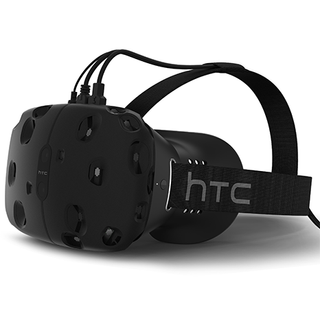Oculus Rift Vs. HTC Vive Vs. PlayStation VR
The Oculus Rift and HTC's Vive are now available and later this year, Sony's Playstation VR is coming out. This guide offers a comparison between the three and will help you device which VR system is right for you.
System Requirements, Availability And Conclusion
System Requirements Compared
All three headsets we are comparing aren’t called high-end for nothing. As the pinnacle of consumer VR they also need close to the pinnacle of computing power to run them. Well, at least the PC-based ones do. The system requirements for PlayStation VR are almost comical in their simplicity: “PlayStation 4” (of course, there’s a little more to it than that).

Looking at the table above, the PC requirements for both the Vive and Rift are fairly similar. Both need high-end GPUs and good CPUs, with the biggest difference between them being the RAM requirements and USB ports needed. Although these high requirements equate to high costs to upgrade your PC if you don’t meet the specs needed, or are planning on buying or building a new PC, keep in mind that both the GTX 970 and R9 290 are two and three-years-old respectively, and are more affordable than ever, especially with even newer GPU platforms upon us. Last, at least on the Vive/Steam VR front, Valve has been actively pursuing new rendering techniques and optimizations (that Alex Vlachos outlined at GDC this year) to lower the system requirements of high-end VR, so you don’t need to own a top of the range video card.
If upgrading your PC or building a new one isn’t your cup of tea the other option is to buy (at a higher cost than building your own, of course) a pre-built system. Both HTC and Oculus have VR-certified options from different OEMs advertised on their sites. Oculus promotes Alienware, Asus, Dell, and Falcon Northwest and HTC links to VR-ready desktop hardware from Alienware and HP, and notebooks from MSI. Some of these VR-ready PCs are also available from select retailers in bundles with the Rift. Tom's Hardware's community has also recommended a couple of VR-ready builds, one at the low end ($750) and one at the high end ($2500) in our Best PC Builds.
On the surface then, the system requirements for the PlayStation VR blow the other two systems away. All you need is a $350 console, and you’re off to the races. It isn’t that simple though, because the PlayStation 4 has a significant performance deficit when compared to even the Vive and Rift’s minimum requirements, and, no, as we said before its Processing Unit doesn’t add any horsepower to the PS4.
So, in addition to the specs of the HMD themselves having to be lower (display resolution mainly), with Sony’s insistence of a 60 fps level of performance, there are going to have to be some significant compromises. The graphical fidelity of the PlayStation VR’s games we’ve tried is lower when compared to those of the Vive and Rift. No, graphics aren’t everything, and we’re sure that despite any visual shortcomings, PSVR’s games will be just as fun as the Vive and Rift’s. But as the old saying goes, you get what you pay for, and a cheaper headset combined with a less powerful system powering it is going to equal an experience that’s going to be a step-down. Perhaps that’s why Sony is working on the rumored, upgraded, more powerful PlayStation 4 Neo, to level the VR playing field a bit.
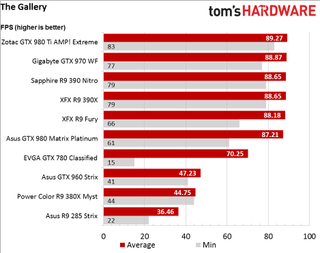
In our full review of the HTC Vive, you can see our full benchmark results from testing a wide selection of video card with the Vive, but the above is shows the results from one of the most demanding Vive games currently available. As you can see the minimum FPS of all the GPUs tested drops below the 90 fps needed for a good VR experience, but from our experience playing the game on the minimum specifications or above were perfectly fine with no hint of framerate issues.
That’s because the tool we used to record the framerate, FRAPS, gathers data from the rendering pipeline before it’s hit the headset where SteamVR’s Interleaved Reprojection can smooth things out. However, as we mentioned earlier, this method of reprojection isn’t as good as what the Rift uses and can lead to brief periods where the frame does drop below an acceptable level before it kicks in. With the graph above showing that there can be some big slowdowns in graphically demanding VR games like The Gallery (or Elite Dangerous), there is a chance there could be a tiny amount of perceptible judder.
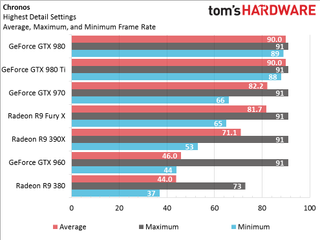
Again, our Oculus Rift review has a full suite of benchmark results, with the results above being from the most demanding Rift title we tested. Again, our data was generated by FRAPS from before anything hits the headset, so isn’t a true reflection of the in HMD performance, which, like the Vive was, was very smooth with no perceptible slowdowns thanks to Asynchronous Timewarp (ATW). What we need to do is to continue to refine our testing progress so we can measure the in-headset performance and truly compare the different platforms.
Pricing And Availability
The table below covers the global pricing and availability of all three headsets, and even though we’ve been focused on talking about the PlayStation VR Bundle in this article, at this time it’s a North American exclusive – in other regions you have to but the PSVR and its required accessories separately.
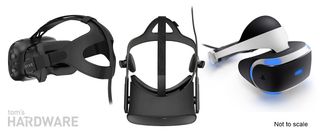
| Country | Vive Price | Rift Price | PlayStation VR Bundle | PlayStation VR |
|---|---|---|---|---|
| U.S. | $799.00 (sales tax not included) | $599.00 (sales tax not included) | $499.00 (sales tax not included) | $399.00 (sales tax not included) |
| Australia | USD $899.00 | AU $649.00 | N/A | AU $550 |
| Canada | CDN $1,149.00 (sales tax not included) | CDN $849.00 (sales tax not included) | $699.00 (sales tax not included) | $549.00 (sales tax not included) |
| China | RMB ¥6,888.00 (¥1,500.00 order deposit) | N/A | N/A | N/A |
| Taiwan | NT $28,288($6,000 order deposit) | USD $649.00 | N/A | TBA |
| Japan | USD $979.00 | ¥83,800.00 | N/A | ¥44,980.00 |
| United Kingdom | £689.00 | £499.00 | N/A | £349.00 |
| New Zealand | USD $949.00 | NZ $699.00 | N/A | NZ $629.00 |
| AustriaBelgiumDenmarkFinlandFranceGermanyIcelandIrelandItalyNetherlandsNorwayPolandSpainSwedenSwitzerland | €899.00 | €699.00 | N/A | €399.00 |
| Czech Republic | €899.00 | N/A | N/A | €399.00 |
| Availability | 4 – 6 weeks from order date | Earliest order shipment August 2016 | October 2016 | October 2016 |
| Retail/E-tail Availability | Amazon, Best Buy, Microsoft Store | TBA Summer 2016 | All major electronics retailers | All major electronics retailers |
All three headsets are available across North America, Europe and in key (affluent) markets in Asia-Pacific. Because the Vive gives you the most out of the box, it costs the most, especially when compared to the PlayStation VR bundle that also includes motion controls. Even though the Rift occupies the middle ground, keep in mind to bring it to feature and functionality parity with HTC’s headset, you’ll need to buy the Touch controllers too. Though we have no idea how much they’ll cost, we’re sure that when you factor them into the equation, the Rift is likely to end up costing the same as the Vive.
As of when this article was written both HTC and Oculus have been experiencing some delays getting headsets to customers, with those who want a Rift having it the worst – there’s a 3-month wait from today. If you want a Vive, the wait is going to be a lot less, but at this time, it’s still going to take around four to six weeks for one to ship to you. With PlayStation VR not coming out until October it’s pointless trying to speculate how its launch will go, and if there will be any delays, but with Sony’s having many more years of experience manufacturing and selling consumer hardware, we’re sure the wait to get a PSVR once it launches won’t be as long. Still, PSVR won’t be growing on trees, so there is likely to be some initial supply and demand issues with it too.
Conclusion
We’ve had a lot to say about the three headsets, and we know it’s a lot to take in.
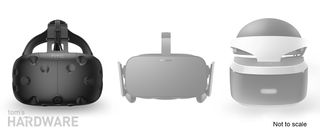
The Vive has a lot going for it, and it's certainly the most complete package of all the VR headsets. You get the most stuff in the box, and there is nothing else you need to buy for the full-range of VR experiences, from seated to large room-scale games. Its optics and visuals are excellent, it has the widest field of view, the best tracking system and includes a pair of tracked motion controllers. It’s also the most adjustable headset for those who wear glasses, and the Steam store and SteamVR software has the most functionality and provides the best UX. The only disappointment is that if you are comparing its design side-by-side with the Rift and PlayStation VR it clearly isn’t the winner. Although it is comfortable to wear, even for extended periods, its ergonomics can’t compare with those of the other two headsets.
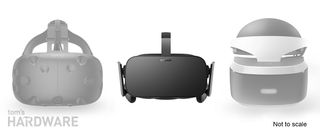
If this comparison were about the headset alone, the Rift would be the clear winner here. Oculus has clearly put a lot effort into designing the most comfortable HMD it can, and combining it with class-leading optics and display technology, excellent built-in audio and perfect tracking. When you are wearing the Rift, and it is properly adjusted, it almost feels like it isn’t there. Unfortunately, Oculus decided to launch this amazing headset with the worst (for VR) method of control, an Xbox One gamepad, and when it comes to the quality of the VR experiences you can have on the Rift, they simply aren’t as impactful as those on the Vive.
The Rift’s software and UX also leave a lot to be desired. Yes, the setup process is excellent and very easy to follow, even for the most inexperienced user, but the Oculus Home store and in-headset UI is half-baked and demonstrates Oculus’ inexperience in software. However, unlike hardware that can’t be fixed without redesigning or replacing something, software can be patched, and you can, of course, also use the Rift with Steam VR too. The Rift does have a wild card, though. That’s its upcoming Touch controllers, which could be a game changer. They look to be excellent, perhaps better than the Vive’s controllers, and if priced right, and combined with a release of some compelling room-scale VR experiences, the Rift could be elevated to be the best overall VR package.
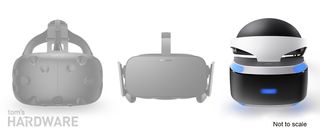
Because we haven’t been able to spend nearly as much time with PlayStation VR, there is quite a bit still that we don’t know about it, mostly on the software side of things. However, with the years of experience with its PlayStation consoles, we do expect the UX and UI of PSVR to be excellent and comparable, possibly better than SteamVR. It is also the most comfortable of all three headsets, even compared to the Rift because it’s ergonomic design is very different. Its weight is better distributed on your head, and its display box doesn’t press into your face.
It also has excellent optics and display technology that partially make up for the gap in its raw specifications, and if you buy the Bundle, it comes with tracked controllers out of the box. Despite all that good, though, there’s no denying that as the cheapest headset (that is going to be powered by a system packing low-end CPU and GPU technology from three years ago) that the overall fidelity of its VR experiences isn’t going to be as good as that of the Vive. Is that as important? Perhaps not to everyone, and we’re sure that PSVR will offer some compelling, innovative and immersive VR experiences.
MORE: The History of Virtual Reality
MORE: The HTC Vive VR Launch TitlesMORE:
AMD Liquid VR ExplainedMORE:
Nvidia GameWorks VR Explained
MORE: The Past, Present, And Future Of VR And AR: The Pioneers SpeakMORE:
The Key To Virtual Reality Immersion Is The Audio
Alex Davies is a Contributing Writer for Tom's Hardware, covering Smartphones and Tablets. Follow him on Twitter.
Current page: System Requirements, Availability And Conclusion
Prev Page Safety, Software And ComfortStay On the Cutting Edge: Get the Tom's Hardware Newsletter
Join the experts who read Tom's Hardware for the inside track on enthusiast PC tech news — and have for over 25 years. We'll send breaking news and in-depth reviews of CPUs, GPUs, AI, maker hardware and more straight to your inbox.
-
nitrium Apparently the PSVR has already been hacked to work on PCs (and Sony is considering official PC support after launch) - I wonder if it might be the best headset to get IF you have a PC, given that from this article at least the number one issue with PSVR is the PS4 it's being attached to.Reply -
problematiq I feel the PSVR got a bit over hyped in this article, in all fairness though it's not released yet so not a lot to go on. As an owner of the HTC Vive I can say "Yes your face will get warm/sweaty if you are in a warm room". I keep a fan blowing tword the center of the room to fix that problem, plus it makes me feel like I'm feeling the wind in VR. o.o All in all was the best purchase I've made in sometime. My wife who does not really like to play games enjoys it A LOT. It is also just a really hard experience to describe other than "Awesome". I don't know how I would feel without the full room scale and motion controllers, I think it would feel novel like playing games in 3D, sure it's cool but not practical and after a while your glasses sit there gathering dust. The ability to reach over and more or less grab and object, play around with it and even toss it, I'm just not sure how I could take off the HMD and put on the Rift and have an experience as good as that of the Vive. All of the HMD's are heading twords the same goal in the end though and it's evident.Reply -
Jeff Fx >and they don't have low refresh rate displaysReply
I think you wrote "low" when you meant "high." -
Zapin So comparing one currently non-existant HMD to two others (one of which is still an incomplete experience) that run on a totally separate platform? Makes sense to me.Reply -
picture_perfect Wait for Polaris / Pascal cards later this month which will be 2X faster in VR apps. Well that is the Nvidia claim. Other VR specifics mentioned like (ray trace audio, specialized projection ect.). These are the first "VR cards".Reply -
Sven Viking The C:-drive-only issue was fixed a while ago, by the way, though (for now at least) you still need to choose one drive and stick to it rather than being able to split games between drives.Reply
For international pricing, don't forget to take high shipping costs and (for Vive to AU/NZ at least) customs fees into account. -
problematiq Reply17976471 said:Wait for Polaris / Pascal cards later this month which will be 2X faster in VR apps. Well that is the Nvidia claim. Other VR specifics mentioned like (ray trace audio, specialized projection ect.). These are the first "VR cards".
I run a 980 TI with the Vive and my load barely see's 30% I'm not sure what you are gaining for waiting on a "VR Card" -
Deric_ How can PSVR do roomscale with only a single camera?Reply
Your controllers will get occluded everytime your body is between them and the camera.
If you have to face a single direction to play, then it is not room scale. -
alex davies ReplyApparently the PSVR has already been hacked to work on PCs (and Sony is considering official PC support after launch) - I wonder if it might be the best headset to get IF you have a PC, given that from this article at least the number one issue with PSVR is the PS4 it's being attached to.
A PC-compatible PSVR would only be the best VR headset from a price perspective. Yes, having a PC power it would improve the fidelity of the in-game graphics, but despite being the most ergonomic, it's still a step below both the Rift and Vive technically. Well, Rift + Touch, because as the moment the lack of tracked controllers handicaps the Rift. -
alex davies Reply>and they don't have low refresh rate displays
I think you wrote "low" when you meant "high."
Fixed, thanks!
